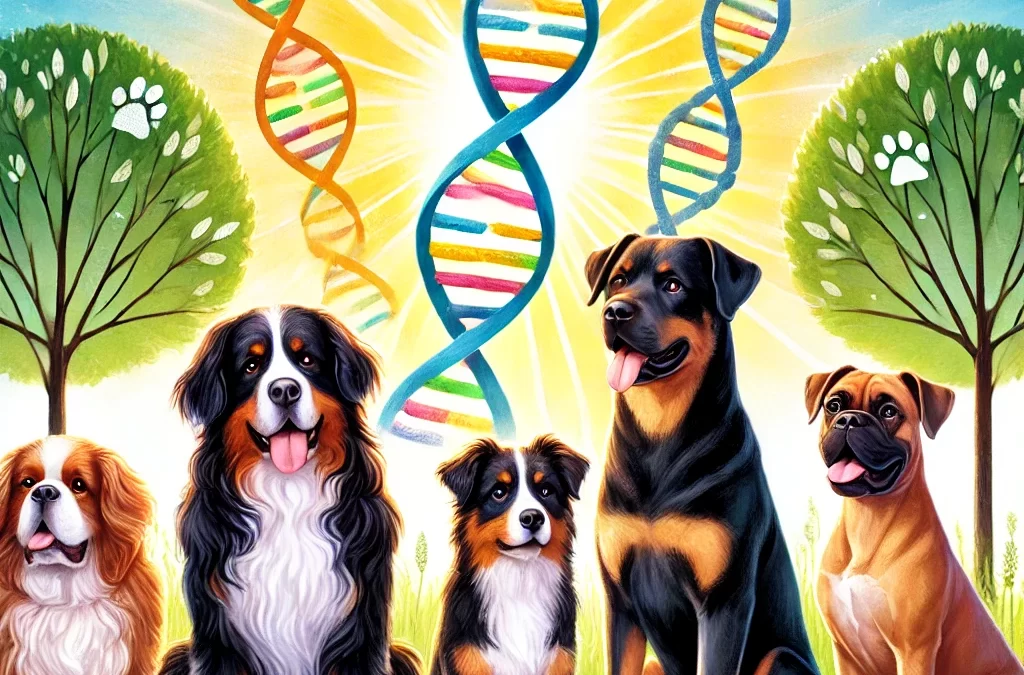
執筆者 TCMVET | 2024年12月6日 | 犬の癌と腫瘍
犬の卵巣がんはまれで、多くの場合は静かに侵入し、私たちの愛するペットの生活にさりげなく入り込んできます。一般的な犬のがんとは異なり、卵巣がんは初期段階で必ずしも明白な症状を呈するわけではないため、最も注意深いペットの飼い主にとっても発見が困難です。この記事では、あまり議論されていないこのトピックを深く掘り下げ、すべての犬の飼い主が知っておくべき症状と早期警告サインを明らかにします。
犬の卵巣がんについて理解する
卵巣がんは、卵巣の異常な成長によって発生し、避妊手術を受けていない中年以上の雌犬に多く見られます。避妊手術の実施が増え、リスクが大幅に減少したため、この病気はまれです。しかし、避妊手術を受けていない犬の場合、体内に潜む静かな捕食者の危険は残ります。
初期症状:病気のささやき
卵巣がんの症状は他の健康問題と重なることが多く、早期発見が困難です。より深刻な問題を示唆する微妙な兆候は次のとおりです。
- 異常な発情周期
犬の発情周期が不規則になったり、長引いたり、突然止まったりする場合は、卵巣の異常を示している可能性があります。
- 腹部の肥大
体液の蓄積(腹水)または腫瘍の増大により、犬の腹部に顕著な腫れが生じることがあります。
- 行動の変化
無気力、イライラ、落ち着きのなさは、内部の変化によって引き起こされる不快感や痛みの兆候である可能性があります。
- Loss of Appetite and Weight
食事への興味の欠如と原因不明の体重減少は、早期の危険信号となることがよくあります。
- 分泌物または出血
膣分泌物は、特にそれが異常であったり、通常の発情周期外で起こったりする場合は、直ちに獣医の診察を受ける必要があります。
進行した症状: 沈黙が破られるとき
卵巣がんが進行するにつれて、より顕著で重篤な症状が現れることがあります。
- 呼吸困難: 癌が肺に転移した場合に起こることがあります。
- 跛行:骨への転移の兆候。
- 目に見える腫瘤: 腹部またはその周囲の領域に触知できる腫瘍。
- 重度の無気力と衰弱: 全身的な感染拡大と健康状態の悪化を示します。
診断:早期発見の重要性
卵巣がんは、診断画像(超音波またはX線)と血液検査の組み合わせによって最も効果的に診断されます。疑わしい腫瘤の生検または穿刺吸引により、がんの存在を確認できます。特に避妊手術を受けていない犬の場合、定期的な獣医による検査は早期発見に不可欠です。
予防と避妊:命を救うステップ
犬の卵巣がんを予防する最も効果的な方法は避妊手術です。避妊手術は卵巣がんのリスクを排除するだけでなく、子宮蓄膿症などの他の生殖器系のがんや病気の可能性も減らします。
犬の癌に対するホリスティックケア
卵巣がんと診断された犬の場合、ホリスティックケアは、手術、化学療法、放射線療法などの従来の治療法を補完することができます。抗炎症食、免疫力を高めるサプリメント、ストレス軽減療法を取り入れることで、ペットの生活の質を高めることができます。
- ハーブサポート: 抗炎症作用と解毒作用があることで知られるターメリックやミルクシスルなどのサプリメントを検討してください。
- 食事の調整高タンパク質、低炭水化物の食事は、がんの増殖を遅らせるのに役立つ可能性があります。
- 心のケアこの困難な時期に、愛、気遣い、慰めの力を決して過小評価しないでください。
揺るぎない絆
犬が卵巣がんと診断されると、悲痛な思いをしますが、同時に、愛犬との深い絆を痛切に思い出させてくれます。あらゆる症状、兆候、行動は、私たちと愛犬との関係を特徴づける無条件の愛の証なのです。
卵巣がんの微妙な兆候を理解し、積極的な対策を講じることで、私たちは愛犬をよりよく守り、愛犬が最も幸せで健康な生活を送れるようにすることができます。結局のところ、愛犬は私たちから最高のケアを受けるに値するのです。

執筆者 TCMVET | 2024年12月5日 | 犬の癌と腫瘍
犬の下腸に異常な腫瘍ができると、不快感から命に関わる状態まで、重大な健康問題を引き起こす可能性があります。これらの腫瘍は、直腸や結腸に発生することが多く、良性の場合も悪性の場合もあります。原因、症状、治療の選択肢を理解することは、適切なタイミングで介入するために重要です。
一般的な腫瘍の種類
- ポリープ
- ポリープは腸の内壁に発生する良性の腫瘍です。
- 軽度の出血、下痢、便秘を引き起こす可能性があります。
- 治療しないと、ポリープは悪性腫瘍に変化することがあります。
- 腺癌
- 腸の内壁の腺細胞に影響を及ぼす悪性腫瘍。
- これは下部腸がんの中で最も悪性度の高いタイプのがんの 1 つです。
- 効果的な治療には早期発見が重要です。
- 平滑筋肉腫
- 腸の平滑筋に発生するまれなタイプの癌。
- 閉塞や重度の消化器系の問題を引き起こす可能性があります。
- 血管腫と血管肉腫
- これらの血管腫瘍は良性(血管腫)または悪性(血管肉腫)のいずれかになります。
- 多くの場合、出血や貧血を引き起こします。
異常増殖の症状
下部腸に異常な増殖がある犬は、次のような症状を示すことがあります。
- 便に血が混じる: 明るい赤色またはタールのような黒い便。
- 排便時に力を入れる: 排便時の困難または痛み。
- 便の形状の変化: 閉塞により便が細くなったり、リボン状になったりする。
- 下痢または便秘: 排便習慣の持続的な変化。
- Weight Loss: 原因不明の体重減少と食欲減少。
- 嘔吐または無気力: 胃腸障害の兆候。
原因と危険因子
異常な成長の正確な原因はさまざまですが、次のような要因が挙げられます。
- ダイエット: 質の悪い食事や加工食品は炎症や腫瘍の発生につながる可能性があります。
- 年齢と遺伝: 高齢犬や、ボクサー犬やジャーマンシェパード犬などの特定の犬種は、腸の腫瘍になりやすい傾向があります。
- 慢性炎症: 大腸炎のような病気は、犬に腫瘍を発生させる原因となる可能性があります。
- 毒素への曝露: 環境毒素や発がん物質はがんのリスクを高める可能性があります。
診断
獣医師は腸の腫瘍を診断するために、いくつかの方法を組み合わせて使用します。
- 身体検査: 腫瘤を特定するための触診。
- イメージング: 腫瘍を視覚化するためのX線、超音波、またはCTスキャン。
- 内視鏡検査: カメラを挿入して腸を検査し、組織サンプルを採取します。
- 生検: 腫瘍が良性か悪性かを判断するために組織を検査室で分析します。
治療の選択肢
治療方法は腫瘍の種類と重症度によって異なります。
- 外科的除去: ポリープや局所的な腫瘍は、多くの場合、外科手術で切除できます。
- 化学療法または放射線療法: 悪性腫瘍、特に腺癌に使用されます。
- 食事管理: 症状を管理するための高繊維食または処方食。
- 緩和ケア: 進行した症例における疼痛緩和と生活の質の管理。
予防と監視
- 定期検診: 定期的に獣医の診察を受けることで、腫瘍の早期発見に役立ちます。
- Healthy Diet: 天然の高品質の食材を豊富に含む食事は炎症を軽減します。
- リスクのある品種のスクリーニング: 腸の問題を起こしやすい犬種の定期的な検査。
獣医に診てもらうべきとき
犬に直腸出血、慢性的な消化器疾患、または便の著しい変化の兆候が見られる場合は、すぐに獣医に相談することが重要です。早期の診断と治療により、結果が劇的に改善されます。
ペットの飼い主は、情報を入手し積極的に行動することで、犬の健康をより良く守り、問題が深刻化する前に対処することができます。

執筆者 TCMVET | 2024年12月5日 | 犬の癌と腫瘍
がんは、世界中で犬の死亡原因の上位にランクされています。遺伝的素因が議論の焦点となることが多いですが、さらに深く調査してみると、環境要因がこれまで考えられていたよりもはるかに大きな役割を果たしている可能性があることがわかります。このトピックを詳しく調べ、犬のがんの本当の最大の原因に関する驚くべき真実を明らかにしましょう。
遺伝を超えて:環境要因が中心となる
がんの原因を遺伝のせいにするのは簡単です。結局のところ、ゴールデンレトリバーやボクサーのような特定の犬種は、リンパ腫や肥満細胞腫などのがんを発症しやすいのです。しかし、専門家はますます、 環境発がん物質 犬の癌の主な原因として、次のようなものが挙げられます。
- 化学物質への暴露: 殺虫剤、除草剤、家庭用洗剤などにより、犬は毎日有害な化学物質にさらされています。これらの物質の多くには発がん性物質が含まれており、時間の経過とともに体内に蓄積される可能性があります。
- 加工食品: ドライフードや缶詰の食品には、長期にわたる炎症や細胞の損傷につながる可能性のある保存料、人工着色料、低品質の原材料が含まれていることがよくあります。
- 大気汚染: 犬は鋭い嗅覚を持っているため、人間よりも多くの環境毒素を吸い込んでしまいます。汚染された空気、タバコの煙、車の排気ガスなどがその原因の一部です。
- 過剰ワクチン接種: ワクチンは不可欠ですが、過剰なワクチン接種は、注射部位肉腫などの特定の癌につながることが分かっています。犬の特定のニーズに合わせてワクチン接種スケジュールを調整することが重要です。
炎症:静かな触媒
慢性炎症も重要な要因です。未治療のアレルギーから肥満まで、炎症は癌細胞が増殖するのに最適な状況を作り出します。これは、犬の健康に対する総合的なアプローチの重要性を強調し、物理的ストレスと環境的ストレスの両方に対処することの重要性を示しています。
予防は最良の治療法
犬のがんの最大の原因が環境要因である場合、予防戦略が最善の防御策となります。ペットの飼い主が実行できる対策は次のとおりです。
- 自然な食事に切り替える: 保存料を含まない新鮮な自然食品を選びましょう。ターメリック、ブルーベリー、ブロッコリーなどの抗がん成分を犬の食事に取り入れましょう。
- 水を濾過する: 重金属や毒素への曝露を減らすために、ろ過した水を提供します。
- 化学物質の使用を制限する: 有毒な洗浄製品をペットに安全な代替品に置き換え、家や庭での殺虫剤の使用を減らしましょう。
- 定期的なデトックス: 犬の体から毒素を排除するために、ミルクシスルやクロレラなどの天然の解毒剤を検討してください。
- 定期検診: 早期発見が鍵です。毎月しこりや異常な腫瘍がないか検査し、年に一度は獣医に診てもらい、徹底的な検査を受けましょう。
ホリスティック医学の役割
がんと闘う犬の飼い主の間では、自然療法がますます人気を集めています。鍼治療からハーブサプリメントまで、 TCMVET 白頭霄これらの治療法は、炎症を軽減し、免疫力を高め、全体的な健康を促進することを目的としています。このようなアプローチは、ライフスタイルの変化と組み合わせることで、犬の癌を予防および管理する有望な方法となります。
行動への呼びかけ: 私たちの親友を守る
飼い主である私たちには、犬ががんを引き起こす要因にさらされるのを最小限に抑える力があります。予防、栄養、自然療法に重点を置くことで、がんのリスクを大幅に減らし、愛犬の寿命を延ばすことができます。古い信念に疑問を持ち、新しい習慣を取り入れ、愛するペットの健康を守るために率先して行動しましょう。

執筆者 TCMVET | 2024年12月4日 | 犬の癌と腫瘍
心臓基底腫瘍は、他の犬の癌ほど話題に上りませんが、罹患した犬にとって重大な健康問題となります。これらの腫瘍は心臓基底部付近で発生し、心臓機能に支障をきたすほど大きくなるまで検出されないことがよくあります。この目立たないが深刻な病状を理解することで、犬の飼い主は診断と治療に向けて積極的な措置を講じることができます。
心臓底腫瘍とは何ですか?
心底腫瘍は、心臓の底部またはその周囲に形成される腫瘍で、通常は大動脈や肺動脈などの重要な構造の近くに発生します。最も一般的な 2 つのタイプは次のとおりです。
- 化学切除腫(傍神経節腫): 血液中の酸素濃度を調節する化学受容体細胞から発生する、ゆっくりと成長する腫瘍。
- 異所性甲状腺腫瘍: 心臓の近くにある甲状腺組織から発生するまれな腫瘍。
どちらのタイプも心臓や隣接する組織を圧迫し、重大な心血管系の合併症を引き起こす可能性があります。
心臓基底部腫瘍になりやすい品種
どの犬でもこの腫瘍を発症する可能性がありますが、遺伝的素因により、特定の犬種はより発症しやすい傾向があります。これには以下の犬種が含まれます。
これらの犬種では、年齢を重ねてから症状が現れることが多く、この病気は中年から高齢の犬で頻繁に診断されます。
兆候と症状:微妙な警告
心臓底腫瘍は初期段階では無症状であることが多く、早期発見が困難です。しかし、腫瘍が大きくなるにつれて、以下の症状が現れることがあります。
- 運動不耐性: 犬がかつて楽しんでいた活動を行うことが困難になる。
- 咳: 気管内の体液の蓄積または圧力によって発生します。
- 失神(失神): 血流の阻害により発生します。
- 腹部の腫れ: 心不全による体液の蓄積(腹水)が原因です。
- 呼吸困難: 肺または気道の圧迫を示します。
これらの症状は他の心臓や呼吸器の症状と似ていることが多く、診断を複雑にします。
革新的な診断アプローチ
X 線や心エコー検査などの従来の診断方法は依然として価値がありますが、新しい技術がこの分野を進歩させています。
- CTおよびMRIスキャン: 腫瘍と周囲の構造の詳細な画像を提供します。
- 穿刺吸引生検: 腫瘍の種類を特定し、治療計画を通知するのに役立ちます。
- 遺伝子検査: 新しいツールによって、特定の犬種の素因を特定できるようになるかもしれません。
治療の選択肢: 個別対応アプローチ
心臓底腫瘍の治療は、腫瘍の種類、大きさ、犬の全体的な健康状態などの要因によって異なります。選択肢には以下が含まれます。
- 外科的除去: 小さく局所的な腫瘍には効果的ですが、重要な構造物に近いためリスクを伴います。
- 放射線療法: 手術不能な腫瘍の成長を遅らせ、症状を緩和するためによく使用されます。
- 緩和ケア: 体液貯留などの症状を管理するための利尿剤などの薬剤が含まれます。
自然療法:補完的解決策
代替アプローチを求める飼い主にとって、自然療法は従来の治療法を補完する可能性があります。
- Herbal Supplements: アストラガルスやターメリックなどの処方は、免疫の健康をサポートし、炎症を軽減する可能性があります。
- 鍼治療: 患っている犬の血行を改善し、痛みを和らげます。
- 栄養サポート: 抗酸化物質とオメガ 3 脂肪酸が豊富な食事は、全体的な健康を強化する可能性があります。
自然療法は有益ですが、標準的な治療を妨げないように必ず獣医師に相談してください。
予後: 何を期待するか
心臓基部腫瘍を患った犬の予後は大きく異なります。化学切除腫は一般的にゆっくりと進行し、適切な管理を行えば犬は数か月、あるいは数年生きられることもあります。しかし、悪性腫瘍や手術不能な腫瘍は寿命を縮める可能性があります。定期的なモニタリングとタイムリーな介入が結果を改善する鍵となります。
行動への呼びかけ: 意識を高める
心臓基底腫瘍は獣医学においていまだ十分に認識されていない脅威です。認識を高めることで、罹患した犬の早期診断とより良い結果につながります。リスクのある犬種の飼い主は、定期的な検査を優先し、心臓の問題が疑われる場合は高度な診断を主張する必要があります。
結論
心臓基底腫瘍は複雑で困難な病気ですが、知識は力になります。リスク、症状、利用可能な治療法を理解することで、飼い主は愛犬に最善のケアを提供できます。私たちは力を合わせて、この静かな脅威に光を当て、犬とその家族に希望を与えることができます。

執筆者 TCMVET | 2024年12月4日 | 犬の癌と腫瘍
家族に毛皮の仲間を加えることを検討している場合、健康は意思決定プロセスの重要な要素となるはずです。すべての犬が特定の健康状態にかかりやすい一方で、一部の犬種は遺伝的に癌を発症しやすい傾向があります。これらのリスクを理解することで、情報に基づいた選択を行い、ペットの健康を積極的に管理できるようになります。
なぜ特定の犬種はがんになりやすいのでしょうか?
犬の癌は、人間と同様、遺伝、環境要因、年齢の影響を受けます。特定の特性を持つように選択的に交配された犬種は、癌になりやすい体質など、遺伝的脆弱性を受け継いでいることが多いです。多くの犬種にとって、この不幸な遺産は、望ましい特性を維持することを目的とした何世紀にもわたる近親交配の結果です。
がんリスクが高い品種
1. ゴールデンレトリバー
ゴールデンレトリバーは友好的な性格と知性で愛されていますが、特に癌のリスクが高いです。 リンパ腫 そして 血管肉腫研究によると、ゴールデンレトリバーの約 60% が生涯に癌を発症すると言われています。この驚くべき統計から、ゴールデンレトリバーの癌感受性の理由を明らかにすることを目的とした「ゴールデンレトリバー生涯研究」などの研究イニシアチブが推進されました。
2. バーニーズ・マウンテン・ドッグ
穏やかな性格と印象的な三色の毛皮で知られるバーニーズ・マウンテン・ドッグは、平均よりも高いリスクに直面しています。 組織球性肉腫は、まれではあるが悪性の癌の一種です。比較的短い寿命(6~8 年)は、この病気と関係していることが多いです。
3. ボクサー
ボクサー犬は、遊び心と忠誠心を持ち、さまざまな癌にかかりやすい。 肥満細胞腫 そして リンパ腫彼らの素因は特定の遺伝子変異に関連している可能性があるため、定期的な獣医の診察が不可欠です。
4. ロットワイラー
ロットワイラーは、強くて丈夫な犬として知られているにもかかわらず、 骨肉腫骨がんの一種です。このリスクは特に大型ロットワイラーで高く、体重と関節の健康状態を監視することの重要性が強調されます。
5. スコティッシュ・テリア
スコティッシュ・テリア(愛称スコッティ)は、 移行上皮癌(TCC)膀胱がんの一種です。この犬種特有のリスクは、小型ながらも丈夫なこの犬の尿の健康を観察することの重要性を浮き彫りにしています。
固定観念を打ち破る:小型犬も例外ではない
がんは大型犬種によく見られる病気ですが、小型犬種も例外ではありません。例えば、 ボストンテリア そして ダックスフント それぞれ肥満細胞腫と悪性黒色腫になりやすい。犬のサイズは必ずしも癌のリスクと相関関係にあるわけではないので、すべてのペットの飼い主は注意を払う必要がある。
犬の癌リスクを減らす方法
犬の遺伝子構成を変えることはできませんが、リスクを最小限に抑えるために積極的な対策を講じることはできます。
- 栄養: 抗酸化物質が豊富な食品を含むバランスの取れた食事を犬に与えてください。オメガ 3 脂肪酸などのサプリメントも細胞の健康をサポートする可能性があります。
- 定期的な運動: 健康的な体重を維持するために犬を活発に活動させ、免疫システムへの負担を軽減します。
- 毒素を避ける: 農薬、タバコの煙、その他の発がん物質への曝露を最小限に抑えます。
- 定期検診異常の早期発見のために、毎年獣医の診察を受けるようにしてください。
- 避妊/去勢: 特定の犬種では、これにより生殖器がんのリスクが低下する可能性があります。
革新的な研究:希望の光
最近の獣医学の進歩により、がんになりやすい犬種に希望が生まれています。免疫療法、標的療法、遺伝子検査がより利用しやすくなり、早期発見と個別治療が可能になっています。たとえば、犬のがんゲノムプロジェクトでは、人気のある犬種の遺伝的素因をマッピングし、犬種固有の予防策への道を開いています。
犬種の選択:心からの決断
どの犬種を家に迎え入れるかを決めるには、実用面と感情面のバランスを取る必要があります。がんリスクの高い犬種に惹かれた場合は、潜在的な医療費と慢性疾患の管理に伴う感情面の負担に備えるようにしてください。多くの犬愛好家は、これらの犬種がもたらす喜びは、健康リスクの課題を上回ることが多いことに同意するでしょう。
結論
特定の犬種はがんになりやすい傾向がありますが、意識を高めて積極的にケアすることで、犬の生活の質を大幅に向上させることができます。犬特有の弱点を理解することで、犬にふさわしい愛情とケアを提供でき、悲痛な試練を思いやりと回復力の旅に変えることができます。





